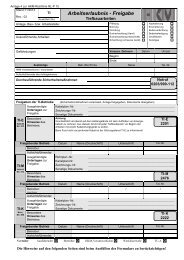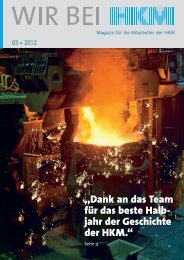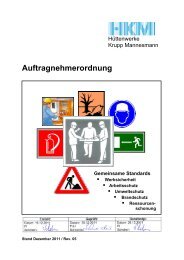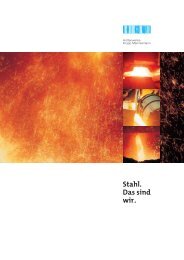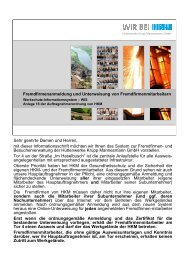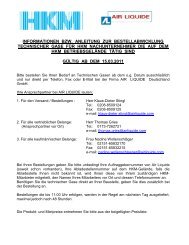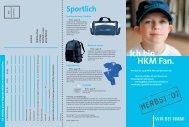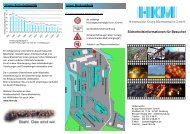At the center for steel - HKM Hüttenwerke Krupp Mannesmann GmbH
At the center for steel - HKM Hüttenwerke Krupp Mannesmann GmbH
At the center for steel - HKM Hüttenwerke Krupp Mannesmann GmbH
Create successful ePaper yourself
Turn your PDF publications into a flip-book with our unique Google optimized e-Paper software.
Steel:<br />
That’s our<br />
business.
The <strong>HKM</strong> <strong>steel</strong>works 2<br />
<strong>At</strong> <strong>the</strong> <strong>center</strong> <strong>for</strong> <strong>steel</strong><br />
Coking plant 4<br />
A basic ingredient<br />
Burden preparation 6<br />
The mixture counts<br />
Blast furnace plant 8<br />
Some like it hot<br />
The melting shop 10<br />
In <strong>the</strong> fluid state<br />
The casting shop 12<br />
Vital strands<br />
Mineral products and Technical Services 14<br />
All-round know-how<br />
Staff and quality 16<br />
The guarantors of success<br />
Industrial safety/Health and environmental protection 18<br />
Responsibility in action<br />
Purchasing/Controlling/IT 20<br />
Getting everything right<br />
<strong>At</strong> a glance 22<br />
A unique range<br />
2<br />
<strong>At</strong> <strong>the</strong> <strong>center</strong><br />
<strong>for</strong> <strong>steel</strong><br />
<strong>Hüttenwerke</strong> <strong>Krupp</strong><br />
<strong>Mannesmann</strong>’s plant is<br />
located in Duisburg, <strong>the</strong><br />
<strong>steel</strong>making heart of<br />
Germany's Ruhr industrial<br />
region. With its work<strong>for</strong>ce<br />
of 3480, <strong>the</strong> company produces<br />
significantly more<br />
than five million tonnes<br />
of <strong>steel</strong> here each year,<br />
The <strong>HKM</strong> <strong>steel</strong>works<br />
equating to approximately<br />
12 percent of all crude <strong>steel</strong><br />
produced in Germany.<br />
Since its <strong>for</strong>mation in 1990<br />
by <strong>Krupp</strong> Stahl AG and<br />
<strong>Mannesmann</strong>röhren-Werke<br />
AG, <strong>HKM</strong> has increasingly<br />
specialized in <strong>the</strong><br />
production of slabs <strong>for</strong>
flat products and in <strong>steel</strong><br />
rounds <strong>for</strong> tube-making.<br />
The range produced thus<br />
corresponds predominantly<br />
to <strong>the</strong> needs of <strong>the</strong><br />
present-day shareholders,<br />
Thyssen <strong>Krupp</strong> Stahl AG<br />
(50 %), <strong>Mannesmann</strong>röhren-Werke<br />
AG (20 %)<br />
and Vallourec & <strong>Mannesmann</strong><br />
Tubes SA (30 %).<br />
<strong>HKM</strong>’s range of supplies<br />
and services includes slabs<br />
with widths of more than<br />
two meters and lengths of<br />
up to twelve meters. Steel<br />
rounds are produced to all<br />
widely used German and<br />
international standards<br />
with diameters of between<br />
180 and 406 millimeters<br />
and lengths of up to 14<br />
meters. These high-quality<br />
<strong>steel</strong> grades, with <strong>the</strong>ir<br />
alloying element contents<br />
of up to 5 percent, meet<br />
<strong>the</strong> most stringent quality<br />
specifications, to permit<br />
<strong>the</strong>ir use, <strong>for</strong> example, in<br />
<strong>the</strong> automotive industry.<br />
The Huckingen location<br />
in Duisburg, and <strong>the</strong>re<strong>for</strong>e<br />
all facilities and plant sections,<br />
are certificated to<br />
<strong>the</strong> international DIN ISO<br />
9001 quality standard,<br />
which also extends to<br />
research and development.<br />
Working and industrial<br />
safety, environmental<br />
protection and quality<br />
are allocated equal priority<br />
within an integrated overall<br />
management system.<br />
3
4<br />
Coking plant<br />
A basic<br />
ingredient<br />
Coal preparation<br />
Bunkers 12 x 200 t<br />
Double-cross mixer 700 t/h<br />
Hammer mill 2 x 100 t/h + 1700 t/h<br />
Coal storage towers 1 x 3000 t / 1 x 500 t<br />
Coal stockyard (capacity) 50,000 t<br />
Coal oil spraying max. 40 t/d<br />
Coking plant<br />
Year of construction 1984<br />
Cross regenerative type coke ovens 70 chambers<br />
Chamber dimensions 18.00 x 7.85 x 0.55 m<br />
Effective chamber capacity 70 m 3<br />
Coke mass, dry 42 t/chamber<br />
Production capacity 1.08 million t/a<br />
Byproducts plant<br />
Gas treatment 60,000 m 3 /h<br />
Annual tar/benzol production 35,000 t / 11,000 t<br />
Sulfuric acid 8,500 t
Reducing agents are<br />
needed to bring iron literally<br />
to <strong>the</strong> boil. Alongside<br />
fuel oil, <strong>HKM</strong> mainly uses<br />
coke to supply its blast<br />
furnaces – up to 1.5 million<br />
tonnes each year. The coke<br />
is needed <strong>for</strong> <strong>the</strong> production<br />
of hot metal, where it<br />
is used <strong>for</strong> reduction of<br />
<strong>the</strong> iron ores to metallic<br />
iron and supplies <strong>the</strong> heat<br />
necessary <strong>for</strong> <strong>the</strong> blastfurnace<br />
process. The use of<br />
high-quality metallurgical<br />
coke is an important precondition,<br />
since properties<br />
such as mechanical<br />
strength and load carrying<br />
capacity at high temperatures<br />
are decisive factors<br />
<strong>for</strong> <strong>the</strong> process.<br />
<strong>HKM</strong> produces <strong>the</strong> major<br />
part of <strong>the</strong> coke required<br />
itself, in <strong>the</strong> world’s largest<br />
single-unit coke oven battery.<br />
Coal is distilled in this<br />
high-capacity battery with<br />
<strong>the</strong> exclusion of air by<br />
means of external input<br />
of heat. Modern environmental<br />
safety provisions<br />
ensure practically emissionfree<br />
coke oven operation.<br />
After complete carbonization,<br />
<strong>the</strong> hot coke<br />
pushed from <strong>the</strong> oven<br />
chambers requires cooling.<br />
<strong>HKM</strong> has developed <strong>for</strong><br />
this operation a wetquenching<br />
process which<br />
achieves coke moisture<br />
contents of less than two<br />
percent in continuous<br />
operation.<br />
In order to attain consistent<br />
high quality, <strong>HKM</strong>’s<br />
own coke is blended in<br />
a screening plant with<br />
bought-in coke and <strong>the</strong><br />
mixture is stabilized and<br />
screened in a fallingimpact<br />
process. The coke<br />
breeze is used in <strong>the</strong> sinter<br />
plant, while <strong>the</strong> lump fraction<br />
is fed into <strong>the</strong> blast<br />
furnace.<br />
The process and production<br />
control systems of<br />
this 1984 coking plant<br />
were long ago converted<br />
to more modern methods.<br />
The same applies to <strong>the</strong><br />
byproducts plant <strong>for</strong><br />
cleaning of <strong>the</strong> coke-oven<br />
gas, which assure attainment<br />
on <strong>the</strong> purity of lowpressure<br />
coke oven gas.<br />
5
Harbour<br />
Quayage 900 m<br />
Surface area 45,000 m 2<br />
Cranes 4<br />
Capacity 11 million t/a<br />
Harbour and blast-furnace stockyard<br />
Capacity 300,000 t<br />
Combined stacker / reclaimer 1 x 1,200 t/h<br />
Blending beds<br />
Number 3<br />
Capacity 3 x 150,000 t<br />
Stacker 1 x 1,500 t/h<br />
Reclaimer 2 x 1,200 t/h<br />
Sinter plant<br />
Capacity 6.0 million t/a<br />
Suction area 420 m 2<br />
Main blower 1 x 730,000 Nm 3 /h<br />
Depression 180 mbar<br />
Ignition furnace 3.1 m; 50 burners<br />
Sinter cooling Two annular shaft coolers<br />
Waste gas dedusting Electrostatic precipitator (EP)/<br />
absorption of dioxines/furanes with lignite coke injection<br />
Waste gas recycling system LEEP<br />
Room dedusting EP<br />
6<br />
The mixture<br />
counts<br />
<strong>HKM</strong>’s modern and highly<br />
efficient blast furnace<br />
facilities make great demands<br />
on <strong>the</strong> feed materials<br />
used. In <strong>the</strong> case of<br />
coke, supplies are assured<br />
by <strong>the</strong> on-site coking plant,<br />
while <strong>the</strong> sinter plant per<strong>for</strong>ms<br />
a similar function<br />
<strong>for</strong> <strong>the</strong> lumpening by <strong>the</strong>rmal<br />
conglomeration of<br />
fines resulting from ore<br />
dressing, coke breeze and<br />
fluxes as well as remnants<br />
of <strong>the</strong> iron and <strong>steel</strong> making<br />
process. Sintering itself<br />
is per<strong>for</strong>med with a moistened,<br />
homogenized, fine-<br />
Burden preparation<br />
particled starting mixture.<br />
This is dumped on a conveyor<br />
grate and <strong>the</strong>n ignited<br />
from above. The carbon<br />
contained in <strong>the</strong> mixture<br />
combusts with <strong>the</strong> air<br />
drawn through <strong>the</strong> grate,<br />
with <strong>the</strong> result that <strong>the</strong> ore<br />
grains are <strong>the</strong>rmally<br />
agglomerated. The resultant<br />
product is exceedingly<br />
permeable to gas and<br />
capable of reduction.<br />
After screening, it is ideally<br />
suitable <strong>for</strong> direct burdening<br />
into <strong>the</strong> blast furnace.
The sintering plant is<br />
equipped with a special<br />
waste gas recycling LEEP<br />
system (Low Emission and<br />
Energy optimised sintering<br />
Process) developed at <strong>HKM</strong><br />
to minimize energy input<br />
and emissions.<br />
Supply of <strong>the</strong> ores and coal<br />
products needed <strong>for</strong> hot<br />
metal production at <strong>HKM</strong><br />
constitutes a great logistical<br />
challenge – in view,<br />
not least of all, of <strong>the</strong> fact<br />
that <strong>the</strong>y are obtained<br />
from all regions of <strong>the</strong><br />
world, and primarily from<br />
Brazil, Canada and Australia.<br />
Following mining, <strong>the</strong><br />
ores are transported in<br />
enormous ore-carriers<br />
with capacities as high<br />
as 350,000 tonnes to <strong>the</strong><br />
harbour at Rotterdam,<br />
where <strong>HKM</strong> partially owns<br />
a terminal. Here <strong>the</strong> cargo<br />
is transferred to barges,<br />
each capable of transporting<br />
some 2,800 tonnes of<br />
ore. These are assembled<br />
units of four barges each,<br />
making it possible to<br />
transport around 11,000<br />
tonnes of ore to <strong>HKM</strong>’s<br />
plant harbour on <strong>the</strong><br />
Rhine in a single movement.<br />
Two ore-handling gantries<br />
and two dock-cranes are<br />
available <strong>for</strong> transfer of <strong>the</strong><br />
cargoes on <strong>the</strong> 900 meter<br />
long quay of <strong>the</strong> harbour<br />
basin. This facility is capable<br />
of handling some ten<br />
million tonnes of material<br />
annually. Of this figure,<br />
around nine million tonnes<br />
is accounted <strong>for</strong> by incoming<br />
supplies (fine ores,<br />
lump ores, pellets, etc.).<br />
Some one million tonnes<br />
of cargo leaves <strong>the</strong> harbour<br />
each year, including<br />
both semi-finished, slag,<br />
and tubing products, and<br />
also o<strong>the</strong>r finished products<br />
of <strong>the</strong> companies<br />
located on <strong>the</strong> iron and<br />
<strong>steel</strong> plant site.<br />
7
Blast furnace AB<br />
Year of construction 1973 1981<br />
Last relining 1998 2000<br />
Hearth diameter 10.3 m 11.0 m<br />
Effective capacity 2449 m 3 2824 m 3<br />
Charging equipment Double bell with<br />
8<br />
moveable armour Rotating chute<br />
Top pressure 2.8 bar 2.8 bar<br />
Blast temperature 1270° C 1350° C<br />
Tuyeres 30 30<br />
Tapping holes 2 2<br />
Capacity 2.5 million t/a 2.7 million t/a<br />
Hot blast stoves<br />
Number 3 3<br />
Dedusting<br />
Top gas dedusting Ring slot washer Radial-flow washer<br />
Casting-house dedusting EP EP<br />
Slag removal<br />
Type Granulation Slag pen<br />
Blast furnace plant<br />
Some like<br />
it hot
Liquid iron temperatures<br />
of about 1,500 degrees –<br />
hot metal production at<br />
<strong>HKM</strong> leaves scarcely anybody<br />
cold.<br />
And that’s just <strong>the</strong> way it<br />
should be – <strong>the</strong> blast furnace<br />
plant where such<br />
hellish heat is generated<br />
is one of <strong>the</strong> highlights of<br />
an integrated iron and<br />
<strong>steel</strong> plant.<br />
The main reason <strong>for</strong> <strong>the</strong><br />
infernal scenario: Iron only<br />
occurs naturally in <strong>the</strong><br />
<strong>for</strong>m of chemical combinations,<br />
predominantly with<br />
oxygen (iron oxide).<br />
In <strong>the</strong> blast furnaces, with<br />
<strong>the</strong> aid of coke and hot<br />
blast <strong>the</strong> bond between<br />
<strong>the</strong> iron and oxygen contained<br />
in lump ore, pellets<br />
and sinter is broken down.<br />
<strong>At</strong> <strong>the</strong> same time, <strong>the</strong> iron<br />
is freed from existing<br />
gangue (impurities) by<br />
melting.<br />
The reactions taking place<br />
during <strong>the</strong> reduction of<br />
iron oxide to iron are<br />
complex. The engineering<br />
know-how is <strong>the</strong>re<strong>for</strong>e<br />
even more important and<br />
valuable. Many years of<br />
experience, combined with<br />
ultra-modern technology,<br />
make it possible to operate<br />
and control <strong>the</strong> reduction<br />
process with <strong>the</strong> very<br />
greatest efficiency while<br />
at <strong>the</strong> same time keeping<br />
<strong>the</strong> energy inputs to a<br />
minimum.<br />
Great importance is also<br />
attached to <strong>the</strong> environmental<br />
safety provisions<br />
applied. The dust-laden<br />
gases released at tapping<br />
of <strong>the</strong> hot metal from <strong>the</strong><br />
blast furnaces are routed<br />
through appropriate systems<br />
<strong>for</strong> cleaning.<br />
9
The converter plant<br />
Hot metal desulfurization<br />
Stands 2, immersion-lance systems (tri-injection)<br />
Converters<br />
Blowing stands 2<br />
Change vessels 3<br />
Vessel capacity 280 t<br />
Specific volume 0.59 m 3 /t<br />
Oxygen blowing rate 2.6 m 3 /t x min.<br />
Capacity 6.3 million t/a<br />
Bottom stirrers 10<br />
Medium Argon/nitrogen<br />
Blowing rate 0.05 m 3 /t x min.<br />
Slag retaining device “<strong>Mannesmann</strong> slag-stopper”<br />
Dedusting<br />
Primary dedusting Wet electric honeycomb filter<br />
Secondary dedusting Bag filter (2.4 million m 3 /h)<br />
Secondary metallurgy<br />
Facilities<br />
Treatment stands 7<br />
of which with vacuum tank degassing (VD) 2 x 2 (1 pump system each)<br />
Alloying systems 3<br />
Stirring Injection lance / bottom stirring<br />
Wire feeder CaSi, CaFe and o<strong>the</strong>rs<br />
Desulfurizing agent Syn<strong>the</strong>tic slag, MPE process<br />
Ladles<br />
Number 18<br />
Lining Basic<br />
10<br />
Hot metal and scrap are<br />
<strong>the</strong> basis of <strong>steel</strong> production.<br />
Pure oxygen is needed<br />
<strong>for</strong> conversion. Injection of<br />
oxygen is <strong>the</strong> business of<br />
<strong>the</strong> converter shop, special<br />
treatments that of secondary<br />
metallurgy.<br />
The converter plant<br />
The venue is <strong>the</strong> <strong>steel</strong>plant,<br />
designed <strong>for</strong> production<br />
of up to six million<br />
tonnes of high-quality<br />
<strong>steel</strong> annually. Liquid hot<br />
metal and scrap are refined<br />
via <strong>the</strong> injection of<br />
oxygen, with lime added<br />
as a slag-generating agent,<br />
in refractory-lined <strong>steel</strong><br />
vessels known as converters.<br />
A fur<strong>the</strong>r effect of<br />
this process is <strong>the</strong> diminution<br />
of so-called “tramp”<br />
elements in <strong>the</strong> feed<br />
materials such as carbon,<br />
silicon, manganese,<br />
phosphorus and sulfur.
The melting shop<br />
In <strong>the</strong> fluid<br />
state<br />
Precise adjustment of <strong>steel</strong><br />
composition is achieved<br />
at <strong>HKM</strong> even with direct<br />
tapping rates of more than<br />
80 percent. The precondition<br />
<strong>for</strong> this: Comprehensive<br />
metallurgical processing<br />
know-how, dynamic<br />
process control and a<br />
computer assisted system<br />
<strong>for</strong> input of alloying elements.<br />
In addition, <strong>HKM</strong>’s<br />
modern change-vessel<br />
converter system permits<br />
<strong>the</strong> replacement of <strong>steel</strong>making<br />
vessels in <strong>the</strong><br />
shortest possible time.<br />
Ultra-high availability is<br />
thus guaranteed in <strong>the</strong><br />
converter plant. The high<br />
logistical challenges presented<br />
by <strong>the</strong> supply of<br />
hot metal and scrap, in<br />
addition to heat and ladle<br />
scheduling, have also long<br />
been controlled by means<br />
of integrated computer<br />
systems at <strong>HKM</strong>.<br />
Secondary metallurgy<br />
Additional treatment of<br />
<strong>the</strong> <strong>steel</strong> is necessary in<br />
order to produce grades<br />
with a particularly high<br />
oxide cleanness and low<br />
nitrogen, hydrogen and<br />
sulfur contents. Both<br />
this, and achievement<br />
of ultra-precise alloying<br />
specifications, are <strong>the</strong><br />
function of secondary<br />
metallurgy.<br />
Corresponding treatment<br />
facilities have been in<br />
place since as early as 1977,<br />
and have been continuously<br />
modernized.<br />
Two ladle tank degassing<br />
units and three argon<br />
stirring stands nowadays<br />
provide an optimum<br />
secondary metal-lurgical<br />
processing line at <strong>HKM</strong>,<br />
fur<strong>the</strong>r supported with<br />
computer-assisted<br />
methods <strong>for</strong> temperature<br />
control and vacuum treatment.<br />
11
Slab Caster I Caster II Caster III<br />
Year of construction 2001 1989 2000<br />
Type Oval-bow caster Oval-bow caster Vertical bending<br />
12<br />
(Twin) caster<br />
Number of strands 4 2 2<br />
Width 325 to 670 mm 800 to 2100 mm 850 to 2100 mm<br />
Thickness 260 mm 260 mm 260 mm<br />
Mould length 700 mm 700 mm 900 mm<br />
Vertical section 3 m<br />
Casting radii 7 bending pts.<br />
Initial radius 5 m Initial radius 5 m Main radius 9.2 m<br />
6 straightening pts. 6 straightening pts. 7 straightening pts.<br />
Supported length<br />
Length up to<br />
27.7 m 27.7 m 36.5 m<br />
flame cutting machine 30 m 30 m 40 m<br />
Max. slab length 12 m 12 m 10 m<br />
Casting speed 0.5 to 1.0 m/min. 0.8 to 1.0 m/min. 0.8 to 1.5 m/min.<br />
Capacity 0.7 million t/a 1.8 million t/a 3.0 million t/a<br />
Round Caster I Caster II<br />
Year of installation 1982 1984<br />
Type Bow caster Bow caster<br />
Number of strands 6 5<br />
Strand diameter 180 to 240 mm 180 to 406 mm<br />
Casting radii<br />
Length up to<br />
10.5/19.5 m 10.5/13.5/18.0/30.5 m<br />
flame cutting machine 31.1 m 36.5 m<br />
Product length 10 to 14 m 8 to 12 m<br />
Casting speed max. 3.5 m/min. max. 3.2 m/min.<br />
Capacity 1.20 million t/a 0.96 million t/a<br />
The casting shop<br />
Vital<br />
strands<br />
<strong>HKM</strong> slabs and tube-making<br />
rounds have to fulfill<br />
ultra-high specifications.<br />
They are used, ultimately,<br />
<strong>for</strong> high-quality <strong>steel</strong>s <strong>for</strong><br />
automotive panelling and<br />
oil-field tubulars, among<br />
many o<strong>the</strong>r applications.<br />
For this reason, <strong>the</strong> liquid<br />
<strong>steel</strong> is cast at <strong>HKM</strong> only<br />
using <strong>the</strong> modern continuous-casting<br />
process. This<br />
makes it possible to guarantee<br />
uni<strong>for</strong>m solidification<br />
and optimum structure in<br />
<strong>the</strong> slabs and tube-making<br />
rounds.<br />
Slab casters<br />
In late 2000, <strong>HKM</strong> again<br />
set vital signals, following<br />
its previous decisive involvement<br />
in <strong>the</strong> development<br />
of <strong>the</strong> process <strong>for</strong><br />
casting of liquid <strong>steel</strong> to<br />
create a continuous strand<br />
with <strong>the</strong> world’s first bowtype<br />
continuous caster in<br />
around 1964. One of <strong>the</strong><br />
world’s most modern slab<br />
casters has now been installed,<br />
after a construction<br />
period of only fifteen<br />
months. The capacity of<br />
<strong>the</strong> new machine now enables<br />
<strong>the</strong> BOF <strong>steel</strong>plant to<br />
produce 400,000 tonnes<br />
of slabs each month.
The 3 m long vertical section<br />
and large casting radius<br />
provide <strong>the</strong> preconditions<br />
<strong>for</strong> outstanding<br />
product cleanness. In addition,<br />
<strong>the</strong> tight roll pitch<br />
and a dynamic spray<br />
cooling water control system<br />
also guarantee good<br />
internal and surface quality.<br />
Fur<strong>the</strong>rmore, Soft Re-<br />
duction of <strong>the</strong> continuouscast<br />
slabs promotes <strong>the</strong><br />
<strong>for</strong>mation of an optimum<br />
<strong>center</strong> zone. This is implemented<br />
by means of socalled<br />
Cyberlink segments<br />
which automatically detect<br />
<strong>the</strong> still liquid <strong>center</strong><br />
of <strong>the</strong> slab and are in use<br />
here <strong>for</strong> <strong>the</strong> first time<br />
anywhere in <strong>the</strong> world.<br />
Additionally, <strong>the</strong> slab<br />
caster 1 was remodelled<br />
obtaining a twin slab<br />
casting machine.<br />
The blooms produced by<br />
this route are used as<br />
input material <strong>for</strong> a<br />
medium strip rolling mill.<br />
Round casters<br />
Two continuous casting<br />
machines are available at<br />
<strong>HKM</strong> <strong>for</strong> <strong>the</strong> production<br />
of <strong>steel</strong> rounds. It is necessary,<br />
in view of <strong>the</strong> given<br />
tapping weights of 280<br />
tonnes, to achieve high<br />
casting speeds, particularly<br />
<strong>for</strong> continuous casting of<br />
small cross-sections.<br />
<strong>HKM</strong>’s many years of experience<br />
have resulted in<br />
successful application of<br />
this process even where<br />
<strong>the</strong> quality requirements<br />
<strong>for</strong> <strong>the</strong> semi-finished product<br />
are at <strong>the</strong>ir highest.<br />
The rounds thus meet all<br />
<strong>the</strong> conditions necessary<br />
<strong>for</strong> production of alloyed<br />
boiler tubes, high strength<br />
oilfield tubulars and <strong>for</strong>ging<br />
grades of all dimensions.<br />
13
All-round<br />
know-how<br />
14<br />
Mineral products and<br />
Technical Services
The perception of potentials<br />
is one thing, <strong>the</strong>ir exploitation<br />
ano<strong>the</strong>r thing<br />
completely. Not at <strong>HKM</strong>,<br />
however. Here, existing<br />
potentials have been recognized,<br />
utilized and consistently<br />
expanded both<br />
in <strong>the</strong> field of mineral<br />
products and in <strong>the</strong><br />
restructuring of technical<br />
services.<br />
Mineral products<br />
Around two million tonnes<br />
of mineral products are<br />
yielded each year at <strong>HKM</strong>,<br />
in addition to coke, sinter,<br />
hot metal, crude <strong>steel</strong> and<br />
continuously cast semifinished<br />
product. Some<br />
80 percent is used in road<br />
and water-system construction,<br />
and also in <strong>the</strong><br />
cement industry, while <strong>the</strong><br />
rest is used in both internal<br />
and external recycling<br />
processes.<br />
With <strong>the</strong> complete utilization<br />
of <strong>the</strong>se products,<br />
<strong>HKM</strong> makes a significant<br />
contribution to <strong>the</strong> conservation<br />
of resources and<br />
energy. This is achieved by<br />
means of systematic control<br />
of mineral product<br />
quality, both within <strong>the</strong><br />
metallurgical processing<br />
stages and on <strong>the</strong> route to<br />
preparation processes in<br />
<strong>the</strong> context of modern<br />
quality assurance systems.<br />
Technical Services<br />
The efficiency of a production<br />
company depends on<br />
<strong>the</strong> fur<strong>the</strong>r refinement,<br />
replacement, availability,<br />
dependability and safety<br />
of existing plant and systems.<br />
<strong>At</strong> <strong>HKM</strong>, <strong>the</strong> Plant<br />
Engineering and Production<br />
departments are responsible<br />
<strong>for</strong> <strong>the</strong>se tasks,<br />
with <strong>the</strong>ir own maintenance<br />
services. They receive<br />
support, inter alia, from<br />
<strong>the</strong> restructured Central<br />
Workshops, which now<br />
per<strong>for</strong>m a large scope of<br />
services previously contracted<br />
outside <strong>the</strong> company,<br />
thus saving expenditure<br />
and efficiently utilizing<br />
existing staff<br />
potentials. The central<br />
focus here is on consistent<br />
orientation around products<br />
and markets. This<br />
is achieved by means of<br />
segmentation into fields<br />
of series work <strong>for</strong> continuous<br />
casting, Large-scale<br />
Iron and Steelplant Work,<br />
and Urgent Iron and<br />
Steelplant Work. Each individual<br />
sector is responsible<br />
in this context <strong>for</strong> <strong>the</strong><br />
entire range of work, including<br />
work preparation;<br />
within <strong>the</strong> segments, individual<br />
work-groups are<br />
responsible <strong>for</strong> per<strong>for</strong>mance<br />
of each job. The<br />
benefits of restructuring:<br />
Short transport routes,<br />
fewer interfaces, less<br />
temporary storage – in<br />
short, more efficient and<br />
competitive provision of<br />
services. In addition,<br />
Technical Services also<br />
maintain infrastructural<br />
facilities such as <strong>the</strong><br />
energy, fluids and communications<br />
networks, and<br />
<strong>the</strong> around five hundred<br />
buildings on <strong>the</strong> <strong>HKM</strong> site.<br />
15
16<br />
The guarantors<br />
of success<br />
No company succeeds on<br />
its buildings and equipment<br />
alone – people are<br />
behind every product and<br />
every service. <strong>At</strong> <strong>HKM</strong>, <strong>the</strong><br />
company’s 3480 staff are<br />
its assurance of success.<br />
And Quality is a far from<br />
unknown word to <strong>the</strong>m.<br />
Staff<br />
Qualification, motivation,<br />
creativity and enthusiasm<br />
are <strong>the</strong> foundations of our<br />
staff’s per<strong>for</strong>mance. In addition,<br />
a climate of mutual<br />
trust creates <strong>the</strong> basis<br />
Staff and quality<br />
<strong>for</strong> identification with<br />
<strong>the</strong> company, <strong>for</strong> teamoriented<br />
work and <strong>for</strong> <strong>the</strong><br />
assumption of responsibility.<br />
<strong>HKM</strong> nurtures this<br />
commitment by promoting<br />
systematic staff development<br />
and continuous<br />
fur<strong>the</strong>r training and qualification<br />
<strong>for</strong> each individual.<br />
Particular importance attaches<br />
in this context to<br />
<strong>the</strong> training <strong>center</strong>, which<br />
utilizes <strong>the</strong> very latest<br />
discoveries and methods<br />
to impart key capabilities
and qualifications. And<br />
not only in <strong>the</strong> context of<br />
initial occupational training,<br />
but also of fur<strong>the</strong>r<br />
training. Thanks to this,<br />
<strong>HKM</strong> is generally able to<br />
meet demands <strong>for</strong> new<br />
technical and managerial<br />
staff from within <strong>the</strong> company.<br />
The development<br />
and fur<strong>the</strong>rance of staff is<br />
just a financial burden,<br />
however – it also produces<br />
tangible benefits. <strong>At</strong> <strong>HKM</strong>,<br />
suggestions <strong>for</strong> improvements<br />
to production procedures<br />
and operations,<br />
technical equipment and<br />
industrial safety have<br />
already produced cost-<br />
savings measurable in<br />
millions of Euro. And<br />
worthwhile rewards <strong>for</strong><br />
<strong>the</strong> suggestion donors<br />
in <strong>the</strong> framework of <strong>the</strong><br />
company’s improvement<br />
suggestion system.<br />
Quality with system<br />
The commitment of <strong>HKM</strong>’s<br />
staff to potential improvements<br />
is a direct benefit<br />
<strong>for</strong> <strong>the</strong> company’s customers.<br />
Continuous improvement<br />
of processes<br />
and simultaneous reduction<br />
of costs enables <strong>HKM</strong><br />
to provide its customers<br />
with effective benefits<br />
and <strong>the</strong>re<strong>for</strong>e with significant<br />
advantages vis-à-vis<br />
<strong>the</strong> competition. And –<br />
because quality is more<br />
than high–value products<br />
and services – <strong>HKM</strong>’s Quality<br />
Management System<br />
covers not only costs, deadline-keeping<br />
and service<br />
provision. Instead, it constitutes<br />
<strong>the</strong> organizational<br />
framework <strong>for</strong> <strong>the</strong> promo-<br />
tion of product, process<br />
and corporate quality, and<br />
extends equally to all procedures,<br />
processes and<br />
members of staff. A particular<br />
emphasis in this<br />
context is always error<br />
avoidance.<br />
<strong>HKM</strong> is certificated as a<br />
company to <strong>the</strong> international<br />
DIN EN ISO 9001<br />
quality standard.<br />
17
Responsibility<br />
in action<br />
18<br />
Industrial safety/Health and<br />
environmental protection
There is absolutely no<br />
reason why ecological,<br />
social and economic interests<br />
should contradict<br />
each o<strong>the</strong>r. Responsible<br />
thinking and action always<br />
includes both economic,<br />
ecological and social aspects.<br />
All three dimensions<br />
are taken into account and<br />
acted upon at <strong>HKM</strong>.<br />
Safety and health<br />
<strong>At</strong> <strong>HKM</strong>, Safety at Work<br />
and staff health have <strong>the</strong><br />
same priority as all o<strong>the</strong>r<br />
corporate objectives. They<br />
are <strong>for</strong>mulated as independent<br />
focuses in <strong>the</strong><br />
Corporate Guidelines.<br />
“Zero accidents” is one of<br />
<strong>the</strong> most important targets.<br />
Staff are actively involved<br />
in ef<strong>for</strong>ts to avoid<br />
accidents and health<br />
hazards on <strong>the</strong> basis of a<br />
guiding safety code; <strong>the</strong>y<br />
also contribute to adherence<br />
to <strong>the</strong> necessary<br />
safety provisions and rules.<br />
In addition, specialized<br />
safety officers and company<br />
doctors, assisted by<br />
honorary safety representatives,<br />
ensure safe equipping<br />
and design of places<br />
of work and working procedures<br />
and, in addition,<br />
promote safety awareness<br />
and safe behavior. All this<br />
is complemented by systematic<br />
provisions and<br />
courses <strong>for</strong> <strong>the</strong> promotion<br />
of staff health. Highly<br />
qualified rescue staff are<br />
available within <strong>the</strong><br />
Industrial Medicine and<br />
Works Fire Brigade teams<br />
to copy with <strong>the</strong> few emergencies<br />
which can never<br />
be entirely excluded.<br />
Environmental protection<br />
Environmental safety has a<br />
long tradition at <strong>HKM</strong>.<br />
Significant achievements<br />
and technical advances<br />
have been made at<br />
Huckingen to permit reductions<br />
in particulates<br />
emissions, noise, water requirements<br />
and energy<br />
consumption. And ano<strong>the</strong>r<br />
success <strong>for</strong> this strategy:<br />
All <strong>the</strong> dust and sludge re-<br />
sulting from air and water<br />
cleaning processes are<br />
100 percent recycled to<br />
usable materials in special<br />
recycling processes. <strong>HKM</strong> is<br />
continuing this trend and<br />
has invested a two-digit<br />
million amount <strong>for</strong> <strong>the</strong><br />
construction of a new biological<br />
waste-water treatment<br />
plant <strong>for</strong> <strong>the</strong> coking<br />
plant alone. It is now possible<br />
to process some<br />
80 cubic meters of wastewater<br />
here per hour. A<br />
fur<strong>the</strong>r investment has<br />
been <strong>the</strong> construction of<br />
a plant <strong>for</strong> preparation<br />
of commercial iron oxide.<br />
This is used <strong>for</strong> <strong>the</strong> collection<br />
of <strong>the</strong> 200,000 tonne<br />
annual production of<br />
dust from filter systems<br />
and <strong>the</strong>ir preparation in<br />
accordance with <strong>the</strong> needs<br />
of <strong>the</strong> user departments<br />
and companies. In order to<br />
ensure fur<strong>the</strong>r continuous<br />
improvement of environmental<br />
protection, <strong>HKM</strong> is<br />
setting up an Environmental<br />
Management<br />
System (EMAS) oriented<br />
around <strong>the</strong> international<br />
DIN EN ISO 14001 environ-<br />
mental standard and <strong>the</strong><br />
EC environmental audit<br />
ordinance. In this context,<br />
each individual member of<br />
staff is also required to<br />
include environmentally<br />
safe behavior as a mandatory<br />
component of his or<br />
her work.<br />
19
Getting<br />
everything right<br />
20<br />
Purchasing/<br />
Controlling/IT<br />
An enormous number of individual<br />
“cogs” are necessary<br />
to enable an entity as<br />
complex as <strong>HKM</strong> to run<br />
smoothly and efficiently.<br />
And it is not always <strong>the</strong> biggest<br />
wheels or departments<br />
which are <strong>the</strong> most important.Without<br />
purchasing,<br />
<strong>for</strong> example, or without<br />
Cost Controlling, or without<br />
modern in<strong>for</strong>mation technology,<br />
only one thing could<br />
happen at <strong>HKM</strong> – nothing!<br />
Purchasing<br />
The Materials department<br />
is responsible <strong>for</strong> <strong>the</strong> obtainment<br />
of all goods and<br />
services necessary <strong>for</strong> <strong>the</strong><br />
production process. The<br />
department acts on fixed<br />
principles:Whe<strong>the</strong>r it’s a<br />
question of German coking<br />
coal <strong>for</strong> <strong>HKM</strong>’s own coking<br />
plant, <strong>for</strong>eign iron ores,<br />
lime additives or scrap –<br />
quality, price and assuredness<br />
of supply are always
decisive. In addition, Materials<br />
is also responsible<br />
<strong>for</strong> <strong>the</strong> supply of raw materials<br />
and <strong>for</strong> purchasing<br />
and correct storage of <strong>the</strong><br />
various auxiliary and operating<br />
utilities, and also<br />
of spare and replacement<br />
components. The department<br />
is also concerned<br />
with <strong>the</strong> obtainment<br />
of complete plant units,<br />
such as blast furnaces,<br />
continuous casters and<br />
machine tools.<br />
Cost controlling<br />
Trust is good – but cost<br />
controlling makes everything<br />
better. On <strong>the</strong> basis<br />
of this motto, this department<br />
provides well-founded<br />
real-time in<strong>for</strong>mation<br />
<strong>for</strong> control of company<br />
processes and <strong>for</strong> <strong>the</strong><br />
achievement of optimum<br />
economic results. An integrated<br />
cost-planning and<br />
steering system, combined<br />
with a permanent, in-process<br />
cost monitoring function,<br />
provide <strong>the</strong> guarantee<br />
of <strong>the</strong> achievement of <strong>the</strong><br />
corporate targets of quality<br />
and cost leadership.<br />
In<strong>for</strong>mation technology<br />
The digital age long ago<br />
arrived at <strong>HKM</strong>. The complexity<br />
of <strong>the</strong> measuring,<br />
monitoring and automation<br />
equipment installed<br />
in a modern blast furnace,<br />
<strong>for</strong> example, is of a value<br />
equal to that of a complete<br />
Boeing 757 aircraft. And<br />
<strong>the</strong> “rest of <strong>the</strong> plant” is in<br />
no way inferior. All departments<br />
and divisions<br />
are networked with one<br />
ano<strong>the</strong>r, and production is<br />
operated and monitored<br />
on a largely computerassisted<br />
basis. Commercial<br />
departments, Human<br />
Resources and <strong>the</strong> technical<br />
departments employ<br />
<strong>the</strong> standard SAP software,<br />
while <strong>the</strong> use of international<br />
standards such as<br />
UNIX, <strong>for</strong> example, is a<br />
matter of course <strong>for</strong> dataprocessing<br />
plat<strong>for</strong>ms.<br />
21
A unique<br />
range<br />
22<br />
<strong>At</strong> a glance<br />
On any view at all, <strong>HKM</strong><br />
has got a lot to offer. Our<br />
range of products includes<br />
semi-finished rounds <strong>for</strong><br />
tube-making and long<br />
<strong>for</strong>ged product, semifinished<br />
slab material <strong>for</strong><br />
hot and cold-rolled strip,<br />
and plate as <strong>the</strong> starting<br />
material <strong>for</strong> welded tubes.<br />
In addition, we can also<br />
supply coal derivatives,<br />
construction materials<br />
derived from iron and <strong>steel</strong><br />
plant slags and a range<br />
sources of ferrous<br />
materials.<br />
Continuous cast rounds<br />
Dimensions: dia. 180 to<br />
406 millimeter.<br />
Length depending on<br />
<strong>for</strong>mat: Length multiples,<br />
7 to 11.3 or 14.2 meter; fixed<br />
length from 0.8 meter.<br />
Steel grades: to all German<br />
and <strong>for</strong>eign standards.<br />
Continuous cast slabs<br />
Dimensions: 260 x 800<br />
to 2100 mm and<br />
260 x 325 to 670 mm.<br />
Length: max. 12 m<br />
Individual weight:<br />
max. 40 tonnes<br />
Grades: to all German<br />
and <strong>for</strong>eign standards.<br />
Coal derivatives<br />
Crude benzene<br />
Raw tar<br />
Sulfuric acid according<br />
Metallurgical slags<br />
Blast furnace coarse slag<br />
Granulated slag<br />
Steel plant slags
Crude <strong>steel</strong> capacity<br />
Slabs 4.8 million t/a<br />
Rounds 2.2 million t/a<br />
Capacity <strong>for</strong> shipment 6.0 million t/a<br />
Salient economic data (2001)<br />
Turnover 1.2 billion €<br />
Paid-up capital 102 million €<br />
Assets 349 million €<br />
Balance sheet total 598 million €<br />
Staff (2001.12.31) 3556<br />
The company<br />
Legal <strong>for</strong>m <strong>GmbH</strong> (= Limited Liability Company)<br />
Start of commercial activity 01.01.1990<br />
Shareholders<br />
Thyssen <strong>Krupp</strong> Stahl AG 50%<br />
Vallourec & <strong>Mannesmann</strong> Tubes SA 30%<br />
<strong>Mannesmann</strong>röhren-Werke AG 20%<br />
23
<strong>Hüttenwerke</strong><br />
<strong>Krupp</strong> <strong>Mannesmann</strong> <strong>GmbH</strong><br />
P.O. Box 25 11 24 · 47251 Duisburg · Germany<br />
Ehinger Strasse 200 · 47259 Duisburg · Germany<br />
Telephone (49) (0) 203 999 – 01<br />
Telefax (49) (0) 203 999 – 44 11<br />
E-mail post@hkm.de<br />
Internet www.hkm.de<br />
<strong>HKM</strong> 05/2002



